With careful planning and planting, your garden pathways and borders can be transformed from ordinary thoroughfares to dynamic spaces that can make a statement and excite the senses. Here are my favorite tips for planting a garden border that’s easy to maintain, beautiful to look at and even deliciously fragrant as you brush by.
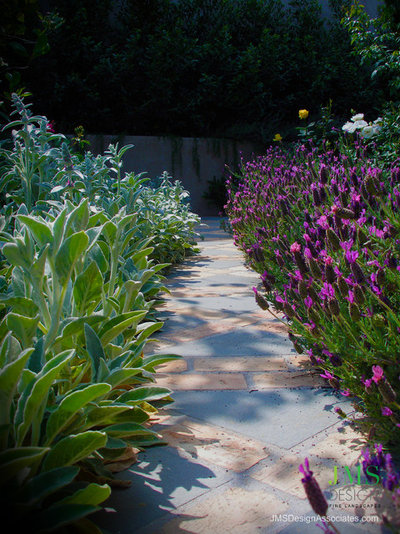
JMSDesignAssociates
Plant Characteristics to Look ForUsing the wrong types of plants could make a pathway awkward to use and result in a very high-maintenance garden. It’s best to look for the following characteristics.
Low and compact growth. Anything too tall or leggy can inhibit movement along the path and restrict visibility to the path ahead or garden beyond.
Taller and more architecturally interesting plants can be used farther back in the bed, away from the path, to create height and foliage contrast. Graduating the height of shrubs and perennials will also make the area appear to be wider than it is.
Lack of spikes and thorns. There is nothing worse than getting scratched or snagged by a plant while walking down a path. Spiky plants are great for little birds but usually best kept away from walkways and driveways to avoid injury.
Tip: I like using flower carpet roses en masse in border beds due to their reliable, long-flowering habit, but they might need to be edged with another plant, such as lamb’s ear (
Stachys byzantina, shown here opposite a border of lavender),
to help create a barrier along the path to reduce the risk of harm. Regular maintenance would also be effective, as would a generously wide walkway.
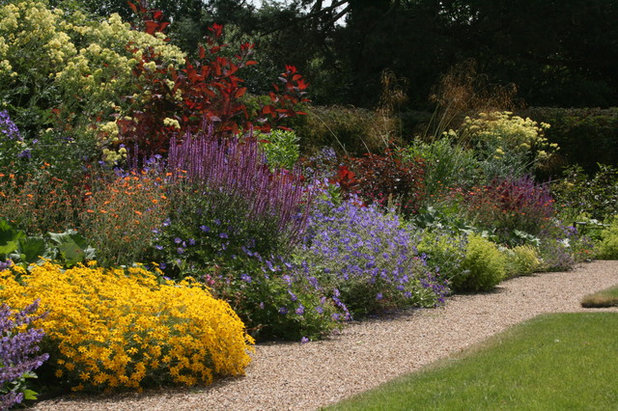
Elemental Designs
Fragrance. Few things are lovelier than catching the aroma of some beautifully fragrant flowers while walking down a path. Sweetly perfumed flowering plants can give you a sensory connection with the garden that can last a lifetime. If you are sensitive to strong perfumes, you can still enjoy this sensation; just choose plants with aromas that suit your nose.
And don’t limit yourself to fragrant flowers when there are so many plants that release delicious scents when you brush against their foliage. Consider plants such as mintbush (
Prostanthera ovalifolia), scented-leaf geranium (
Pelargonium domesticum) in scents of lemon, rose and mint, or the amazing lavenders,
which pack a double punch for having fragrant flowers and foliage.
8 Plants for a Deliciously Fragrant Fall Garden

Dean Herald-Rolling Stone Landscapes
Hardiness to drought and heavy traffic. Paths can become hot, dry zones in the garden due to reflected heat. Keep this in mind if you live in a hot climate.
If your path is likely to experience heavy traffic from time to time, you would be wise to ensure that plants located on the very edge of the path can stand up to moments of careless trampling.
Tip: A nice idea is to use tough ground covers with aromatic foliage between stepping stones or flagstone pavers. The fragrance is released when the plants are stepped on. Look at plants such as low-creeping thyme,
Pratia pedunculata or Corsican mint (
Mentha requienii)
.See how to grow thyme
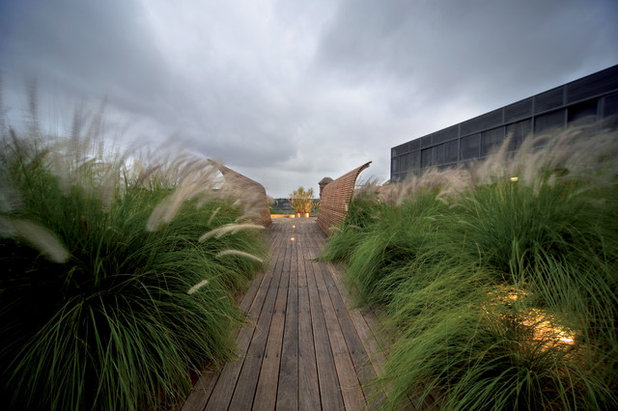
Dale Jones-Evans Pty Ltd Architecture
Tactile plants. Along with fragrant plants, as mentioned above, ones that are soft or interesting to touch add much to your garden experience. I know that I can’t help touching plants positioned at knee or hip height that look soft and inviting.
Tactile gardens are wonderful for children, too, as they help kids gain a greater appreciation for gardens and the individual characteristics of different plants.
The wooden walkway pictured here shows an amazing use of
fountain grass, which has created a surreal space that looks soft and dreamy.
Caution: Some species in the fountain grass genus, including red fountain grass (
Penisetum setaceum), have been identified as invasive plants in California’s wildland.
More about fountain grass | Guides to other ornamental grasses
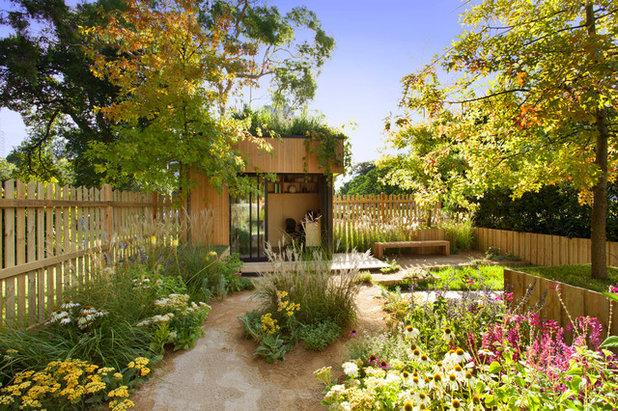
Daniel Tyrrell Landscapes
Long flowering season. This might seem obvious but is easily overlooked and especially important if you want to plant en masse. If your plant of choice is a one-trick pony, you want it to be a showstopper! Look for plants that are easy to care for but produce flowers for at least two seasons or bloom repeatedly.
Browse and compare flowering plants in the Houzz gardening section
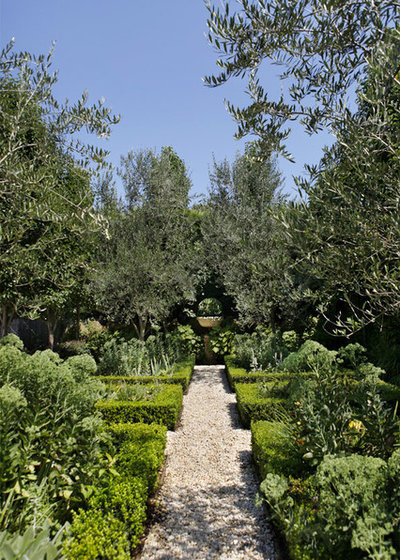
Ian Barker Gardens
What’s Your Garden Style?One of your first considerations should also be style.
Formal. If the house and rest of the garden are formal and have classic style, then your pathway needs to match with neat, structured lines and a balanced planting scheme.
This formal garden perfectly illustrates how the strong, bold lines generated by a low hedge create symmetry. If this is your style, it can be relatively easy to create a wonderful effect, but be sure to use plants suitable to the location.
Once established, this sort of garden can be fairly low maintenance and also allows for creative perennial plantings behind the hedge to ebb and flow without looking messy.
My top tip: Hedges do not have to be confined to formal gardens. Low-clipped hedges are useful for containing the unstructured and more natural plantings of all design styles so they don’t fall into paths.
The next photo shows that not all hedges are created equal. The beautifully sculpted Buxus balls look great all year round, providing an interesting and evergreen garden border.
Houzz guides to garden styles
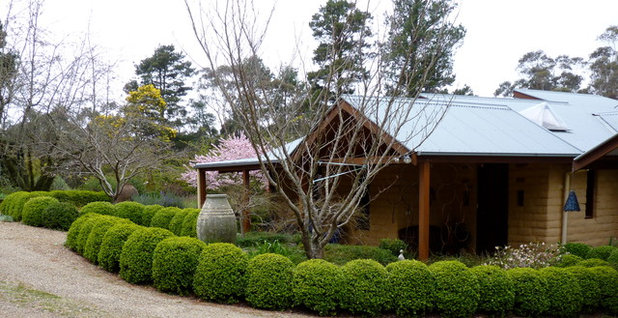
Arthur Lathouris Garden Designer
Informal styles. If your garden style is less formal and relaxed, it may actually take slightly more planning than a formal one. The plantings imitate nature with drifts of plants, shrubs, perennials, bulbs, annuals and herbs alike. They will constantly reward with amazing seasonal displays and endless creative opportunities.
These types of gardens can be faster to establish but may require more maintenance and a deeper understanding of gardening in general.
Design ideas for a natural garden style
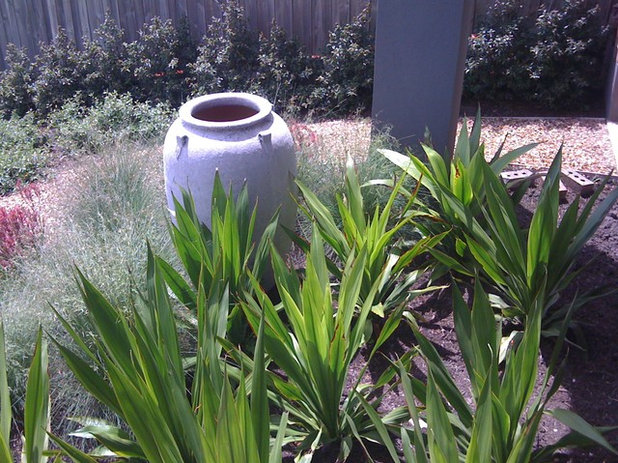
Bespoke Garden Design
Tip: Don’t be restricted to the old-fashioned idea that borders should contain only perennials. Try using a variety of native plants, shrubs (deciduous and evergreen) and grasses for easy-care sections, bold shapes and colors, and year-round interest.
Herbs. Edible plants, including herbs, are also great to use for paths’ borders. Not only do they look good, but you can easily access them for culinary creations on your way through.
Foliage. Foliage-rich borders look amazing and will provide contrast and variety at all times. Don’t be afraid to choose plants for foliage alone — ones with large leaves planted next to ones with fine, small leaves, or bold reds and variegated foliage will provide texture and light in your garden. I often think of these plants as the stalwarts of any garden.
Browse and compare foliage plants
I couldn’t possibly advise on all the viable plant choices available, but I will say, don’t be afraid to think outside the box. Your pathway leads a person from point to point, and it should be inviting or enticing and hopefully say something about the destination. Enjoy!
Tell us: Which plants have you found work well along pathways and garden edges? Please share your favorite pathway plants — and photos — in the Comments.
More photos: Wallow in thousands of inspiring pathways from around the world and save your favorites.





